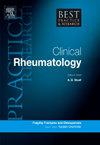Practical utilization of sonography for the assessment of muscle diseases in rheumatology
IF 4.8
2区 医学
Q1 RHEUMATOLOGY
Best Practice & Research in Clinical Rheumatology
Pub Date : 2025-09-01
DOI:10.1016/j.berh.2025.102055
引用次数: 0
Abstract
Muscular manifestations are common complaints encountered in daily rheumatology practice. Magnetic resonance imaging and electromyography are employed to evaluate muscular manifestations associated with myositis and other rheumatologic diseases, but both have limitations that hinder their universal applicability. Ultrasound, on the other hand, has been increasingly used given its utility as a point-of-care tool. There is increasing data that show it is a safe and sensitive tool for screening for myositis. Changes in ultrasound images differ between acute and chronic myositis, and echo intensity has been shown to correlate with muscle strength as well as the number of inflammatory cell infiltrates observed in histopathological analysis. Additionally, it can evaluate non-inflammatory muscular conditions, such as muscular dystrophy, sarcopenia, and certain neurologic disorders that mimic myositis. Despite its potential, its use in clinical practice remains limited due to a lack of physician experience and challenges associated with standardizing and optimizing muscle assessment. This review provides updated knowledge on muscle ultrasound as a practical imaging modality for the evaluation of myositis and other rheumatologic diseases. It discusses settings, techniques, and different assessment methods that will aid in its deployment in clinical practice.
超声在风湿病中评估肌肉疾病的实际应用。
肌肉表现是风湿病学日常诊疗中常见的主诉。磁共振成像和肌电图可用于评估与肌炎和其他风湿病相关的肌肉表现,但两者都有局限性,妨碍了其普遍适用性。另一方面,超声波作为一种护理点工具,已被越来越多地使用。越来越多的数据表明,它是一种安全、灵敏的肌炎筛查工具。超声图像的变化在急性和慢性肌炎之间有所不同,回声强度已被证明与肌力以及组织病理学分析中观察到的炎性细胞浸润数量相关。此外,它还能评估非炎症性肌肉状况,如肌肉萎缩症、肌肉疏松症和某些类似肌炎的神经系统疾病。尽管肌肉超声具有很大的潜力,但由于医生缺乏经验,以及肌肉评估标准化和优化方面的挑战,其在临床实践中的应用仍然有限。本综述提供了有关肌肉超声的最新知识,它是评估肌炎和其他风湿性疾病的一种实用成像模式。它讨论了有助于将其应用于临床实践的设置、技术和不同的评估方法。
本文章由计算机程序翻译,如有差异,请以英文原文为准。
求助全文
约1分钟内获得全文
求助全文
来源期刊
CiteScore
9.40
自引率
0.00%
发文量
43
审稿时长
27 days
期刊介绍:
Evidence-based updates of best clinical practice across the spectrum of musculoskeletal conditions.
Best Practice & Research: Clinical Rheumatology keeps the clinician or trainee informed of the latest developments and current recommended practice in the rapidly advancing fields of musculoskeletal conditions and science.
The series provides a continuous update of current clinical practice. It is a topical serial publication that covers the spectrum of musculoskeletal conditions in a 4-year cycle. Each topic-based issue contains around 200 pages of practical, evidence-based review articles, which integrate the results from the latest original research with current clinical practice and thinking to provide a continuous update.
Each issue follows a problem-orientated approach that focuses on the key questions to be addressed, clearly defining what is known and not known. The review articles seek to address the clinical issues of diagnosis, treatment and patient management. Management is described in practical terms so that it can be applied to the individual patient. The serial is aimed at the physician in both practice and training.

 求助内容:
求助内容: 应助结果提醒方式:
应助结果提醒方式:


